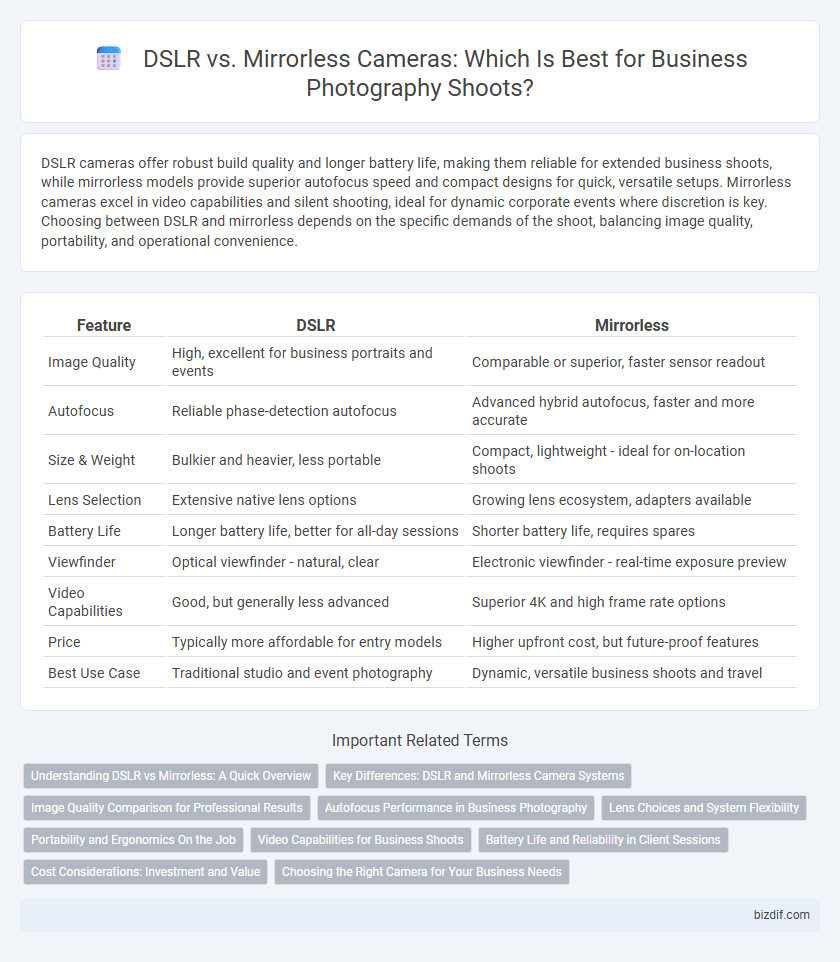DSLR cameras offer robust build quality and longer battery life, making them reliable for extended business shoots, while mirrorless models provide superior autofocus speed and compact designs for quick, versatile setups. Mirrorless cameras excel in video capabilities and silent shooting, ideal for dynamic corporate events where discretion is key. Choosing between DSLR and mirrorless depends on the specific demands of the shoot, balancing image quality, portability, and operational convenience.
Table of Comparison
| Feature | DSLR | Mirrorless |
|---|---|---|
| Image Quality | High, excellent for business portraits and events | Comparable or superior, faster sensor readout |
| Autofocus | Reliable phase-detection autofocus | Advanced hybrid autofocus, faster and more accurate |
| Size & Weight | Bulkier and heavier, less portable | Compact, lightweight - ideal for on-location shoots |
| Lens Selection | Extensive native lens options | Growing lens ecosystem, adapters available |
| Battery Life | Longer battery life, better for all-day sessions | Shorter battery life, requires spares |
| Viewfinder | Optical viewfinder - natural, clear | Electronic viewfinder - real-time exposure preview |
| Video Capabilities | Good, but generally less advanced | Superior 4K and high frame rate options |
| Price | Typically more affordable for entry models | Higher upfront cost, but future-proof features |
| Best Use Case | Traditional studio and event photography | Dynamic, versatile business shoots and travel |
Understanding DSLR vs Mirrorless: A Quick Overview
DSLR cameras feature an optical viewfinder and a mirror mechanism, providing a traditional shooting experience preferred for its durability and battery life in business shoots. Mirrorless cameras, lacking the mirror, offer electronic viewfinders and often more compact designs, enabling faster autofocus and better video capabilities, ideal for versatile business environments. Evaluating factors like image quality, lens selection, and real-time preview helps businesses choose between the robust performance of DSLRs and the innovative technology of mirrorless models.
Key Differences: DSLR and Mirrorless Camera Systems
DSLR cameras use a mirror mechanism to reflect light into an optical viewfinder, offering excellent battery life and durability favored in long business shoots. Mirrorless cameras rely on electronic viewfinders and lack a mirror, resulting in lighter bodies, faster shooting speeds, and improved autofocus performance ideal for dynamic commercial photography. Both systems support interchangeable lenses, but mirrorless models provide advanced features like real-time exposure previews and better video capabilities crucial for versatile business content creation.
Image Quality Comparison for Professional Results
DSLR cameras typically provide superior dynamic range and better battery life, making them reliable for extended business shoots demanding high-resolution images. Mirrorless cameras excel in faster autofocus and more accurate real-time exposure previews, enhancing precision and efficiency in professional environments. Image quality differences have narrowed significantly, with sensor technology advancements allowing both DSLR and mirrorless systems to deliver excellent results suitable for commercial photography.
Autofocus Performance in Business Photography
Mirrorless cameras typically offer superior autofocus performance in business photography due to advanced AI-driven eye and face detection systems, ensuring sharp focus on subjects during dynamic shoots. DSLR autofocus relies on phase-detection modules that perform well in controlled lighting but can lag in fast-paced environments with moving subjects. For photographers prioritizing reliable, precise autofocus in diverse business settings, mirrorless systems often provide a significant advantage in maintaining professional image quality.
Lens Choices and System Flexibility
DSLR cameras offer an extensive range of lenses and robust system compatibility, providing business photographers with versatile options for diverse shooting scenarios. Mirrorless systems excel in compact designs and advanced autofocus, but their lens selections are quickly expanding, often matching or surpassing DSLR offerings in adaptability and innovation. Choosing between DSLR and mirrorless depends on prioritizing legacy lens availability against modern features and system flexibility crucial for dynamic business shoots.
Portability and Ergonomics On the Job
Mirrorless cameras offer superior portability compared to DSLRs, making them ideal for business shoots requiring mobility and quick equipment changes. Their compact design reduces physical strain during extended use, enhancing ergonomics for photographers on the job. While DSLRs often provide a more robust grip and battery life, mirrorless models deliver a balanced combination of lightweight convenience and comfortable handling essential for fast-paced commercial photography.
Video Capabilities for Business Shoots
Mirrorless cameras offer superior video capabilities for business shoots with advanced autofocus, higher frame rates, and better low-light performance compared to traditional DSLRs. Features like in-body image stabilization (IBIS) and 4K recording enhance professional video quality, making mirrorless models ideal for dynamic corporate content creation. DSLRs still provide robust image quality but often lack the cutting-edge video functionalities critical for modern business marketing and client presentations.
Battery Life and Reliability in Client Sessions
DSLR cameras generally offer longer battery life than mirrorless models, making them more reliable for extended business shoots without frequent battery changes. Mirrorless cameras, while sometimes requiring extra batteries, tend to be lighter and more compact, which benefits photographers during long client sessions. Reliability in client sessions often depends on camera build quality and battery management, where DSLRs traditionally excel due to mature technology and robust performance.
Cost Considerations: Investment and Value
DSLR cameras typically offer a lower initial investment compared to mirrorless systems, making them appealing for businesses with tight budgets. Mirrorless cameras provide greater value over time through advanced features like faster autofocus and better video capabilities, which can enhance shoot efficiency and quality. Evaluating total cost of ownership, including lenses and accessories, is crucial for making the best choice between DSLR and mirrorless for professional business photography.
Choosing the Right Camera for Your Business Needs
DSLR cameras offer robust build quality, extensive lens selections, and excellent battery life, making them ideal for prolonged business shoots requiring reliability and versatility. Mirrorless cameras provide superior autofocus speed, compact design, and enhanced video capabilities, which benefit fast-paced commercial environments and content creation. Selecting the right camera depends on specific business needs such as shooting style, portability, and the importance of video versus still image quality.
DSLR vs Mirrorless for Business Shoots Infographic

 bizdif.com
bizdif.com